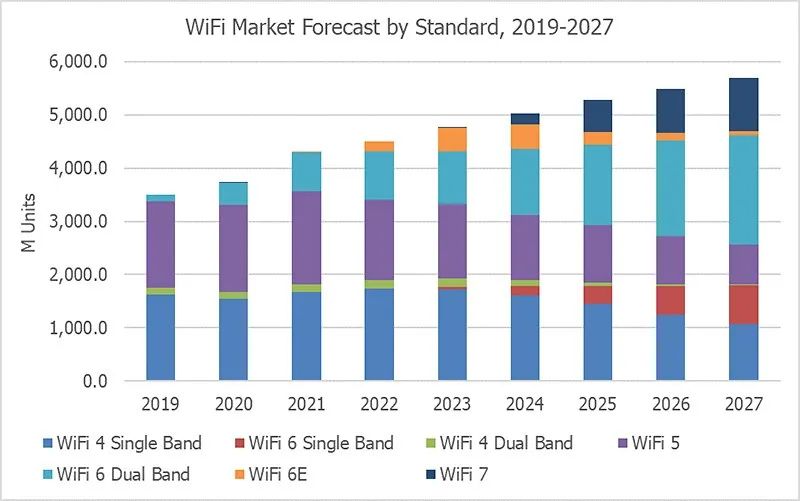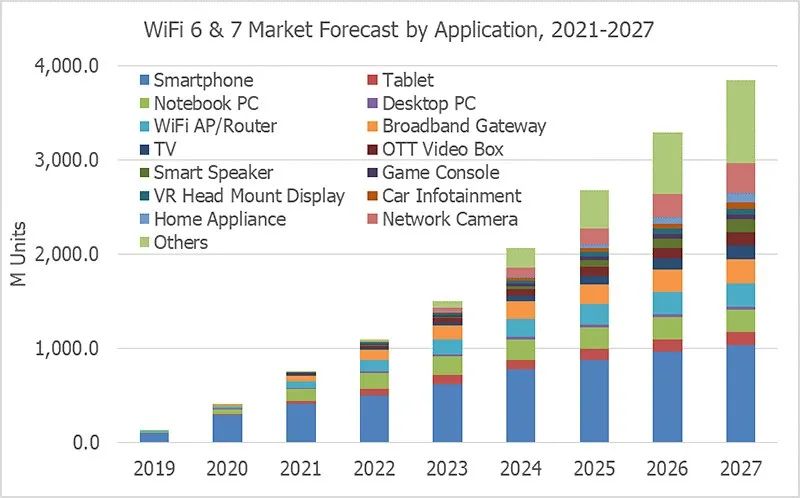Since the advent of WiFi, the technology has been constantly evolving and iterative upgrading, and it has been launched to the WiFi 7 version.
WiFi has been expanding its deployment and application range from computers and networks to mobile, consumer and iot related devices. The WiFi industry has developed the WiFi 6 standard to cover low power iot nodes and broadband applications, WiFi 6E and WiFi 7 add new 6GHz spectrum to cater for higher bandwidth applications such as 8K video and XR display, The added 6GHz spectrum is also expected to enable highly reliable Iiot schemes by improving interference and latency.
This article will discuss the WiFi market and applications, with a special focus on WiFi 6E and WiFi 7.
WiFi Markets and Applications
Following strong market growth in 2021, the WiFi market is expected to grow by 4.1% to reach around 4.5 billion connections by 2022. We forecast rapid growth through 2023-2027, reaching about 5.7 billion by 2027. Smart home, automotive, and embedded iot applications will significantly support the growth in WiFi device shipments.
The WiFi 6 market started in 2019 and grew rapidly in 2020 and 2022. In 2022, WiFi 6 will account for about 24% of the total WiFi market. By 2027, WiFi 6 and WiFi 7 together will account for about two-thirds of the WiFi market. Additionally, 6GHz WiFi 6E and WiFi 7 will grow from 4.1% in 2022 to 18.8% in 2027.
The 6GHz WiFi 6E initially gained traction in the US market in 2021, followed by Europe in 2022. WiFi 7 devices will begin shipping in 2023 and are expected to surpass WiFi 6E shipments by 2025.
6GHz WiFi has great advantages in broadband, gaming and video streaming applications. It will also be an important application scenario in specific industrial iot solutions that require high reliability and low latency communication, such as factory robot automation and AGV. 6GHz WiFi also improves the accuracy of WiFi positioning, so that WiFi positioning can achieve more accurate positioning function at a distance.
Challenges in WiFi Market
There are two major challenges in the 6GHz WiFi market deployment, spectrum availability and additional costs. The 6GHz spectrum allocation policy varies by country/region. According to the current policy, China and Russia will not allocate 6GHz spectrum for WiFi. China currently plans to use 6GHz for 5G, so China, the largest WiFi market, will lack certain advantages in the future WiFi 7 market.
Another challenge with 6GHz WiFi is the additional cost of the RF front-end (broadband PA, switches and filters). The new WiFi 7 chip module will add another cost to the digital baseband/MAC segment to improve data throughput. Therefore, 6GHz WiFi will be mainly adopted in developed countries and high-end smart devices.
WiFi vendors began shipping 2.4GHz single-band WiFi 6 chip modules in 2021, replacing the traditional WiFi 4 that is widely used in iot devices. New features such as TWT (target wake up time) and BSS color increase the efficiency of iot devices by adding lower power operations and better spectrum utilization. By 2027, 2.4GHz single-band WiFi 6 will account for 13% of the market.
For applications, WiFi access points/routers/broadband gateways, high-end smartphones and PCS were the first to adopt WiFi 6 in 2019, and these are still the main applications of WiFi 6 to date. In 2022, smartphones, PCS, and WiFi network devices will account for 84% of WiFi 6/6E shipments. During 2021-22, an increasing number of WiFi applications switched to using WiFi 6. Smart home devices such as smart TVS and smart speakers began adopting WiFi 6 in 2021; Home and industrial iot applications, cars will also start adopting WiFi 6 in 2022.
WiFi networks, high-end smartphones and PCS are the main applications of WiFi 6E/WiFi 7. In addition, 8K TVS and VR headsets are also expected to be the main applications of 6GHz WiFi. By 2025, 6GHz WiFi 6E will be used in automotive infotainment and industrial automation.
Single-band WiFi 6 is expected to be used in low data speed WiFi applications such as home appliances, household iot devices, webcams, smart wearables, and industrial automation.
Conclusion
In the future, the way we live will be changed by the Internet of Things, which will require connectivity, and the continuous increase of WiFi will also provide great innovation for the connection of the Internet of Things. According to the current standard progress, WiFi 7 will greatly improve the wireless terminal application and experience. At present, home users may not need to follow suit and pursue WiFi 7 devices, which can play a more valuable role for industry users.
Post time: Aug-15-2022

